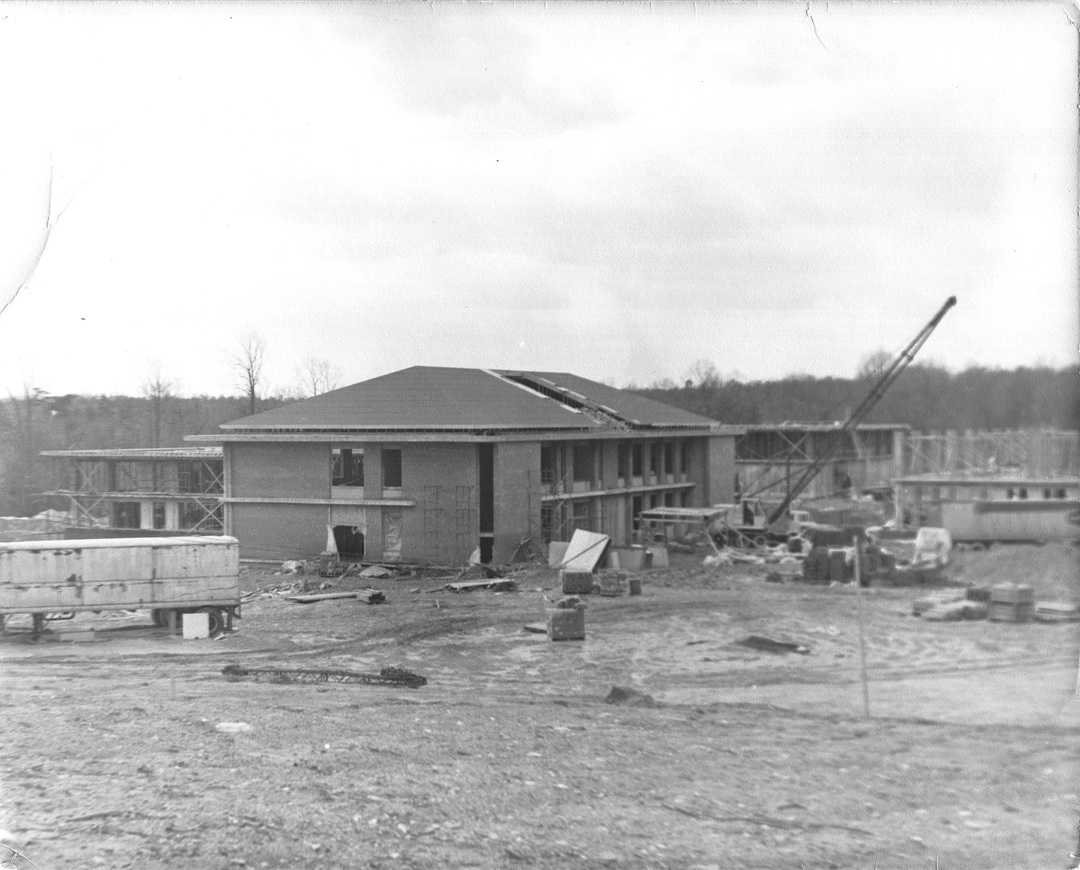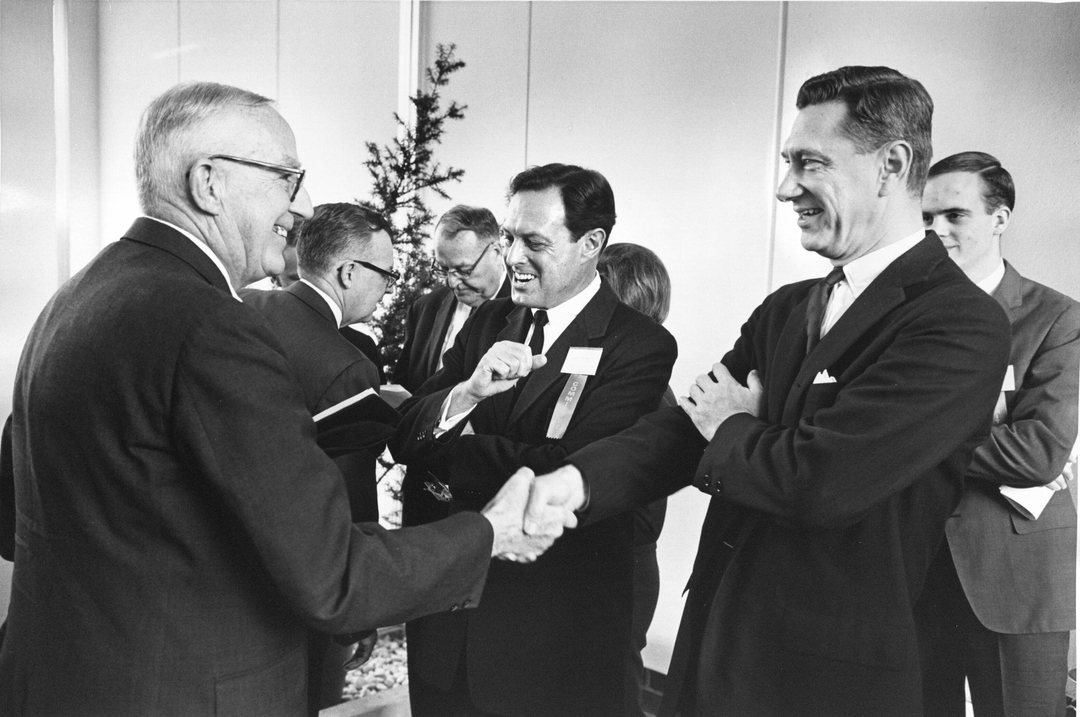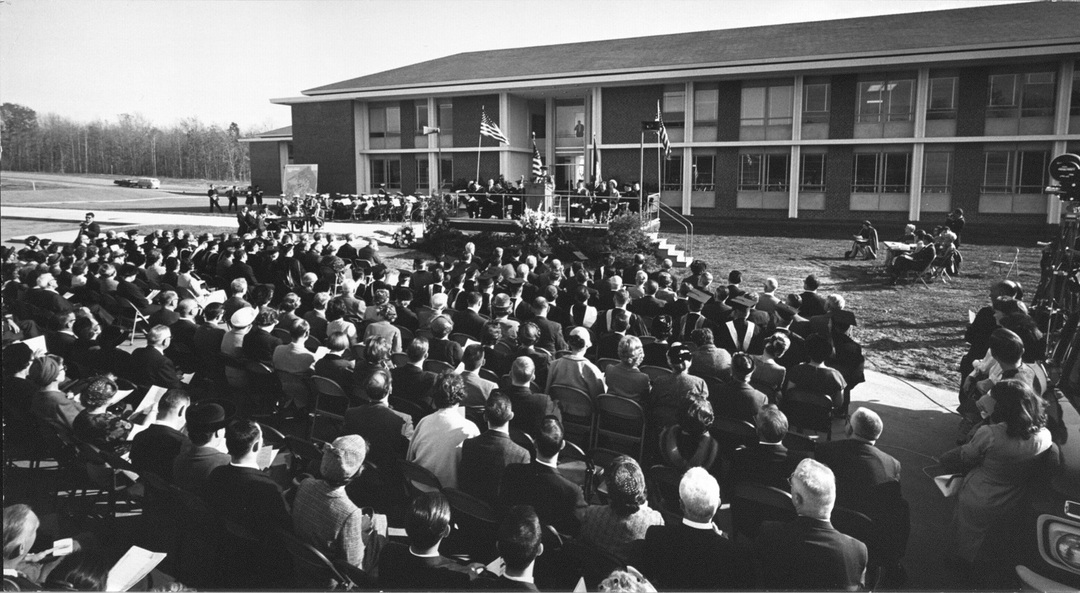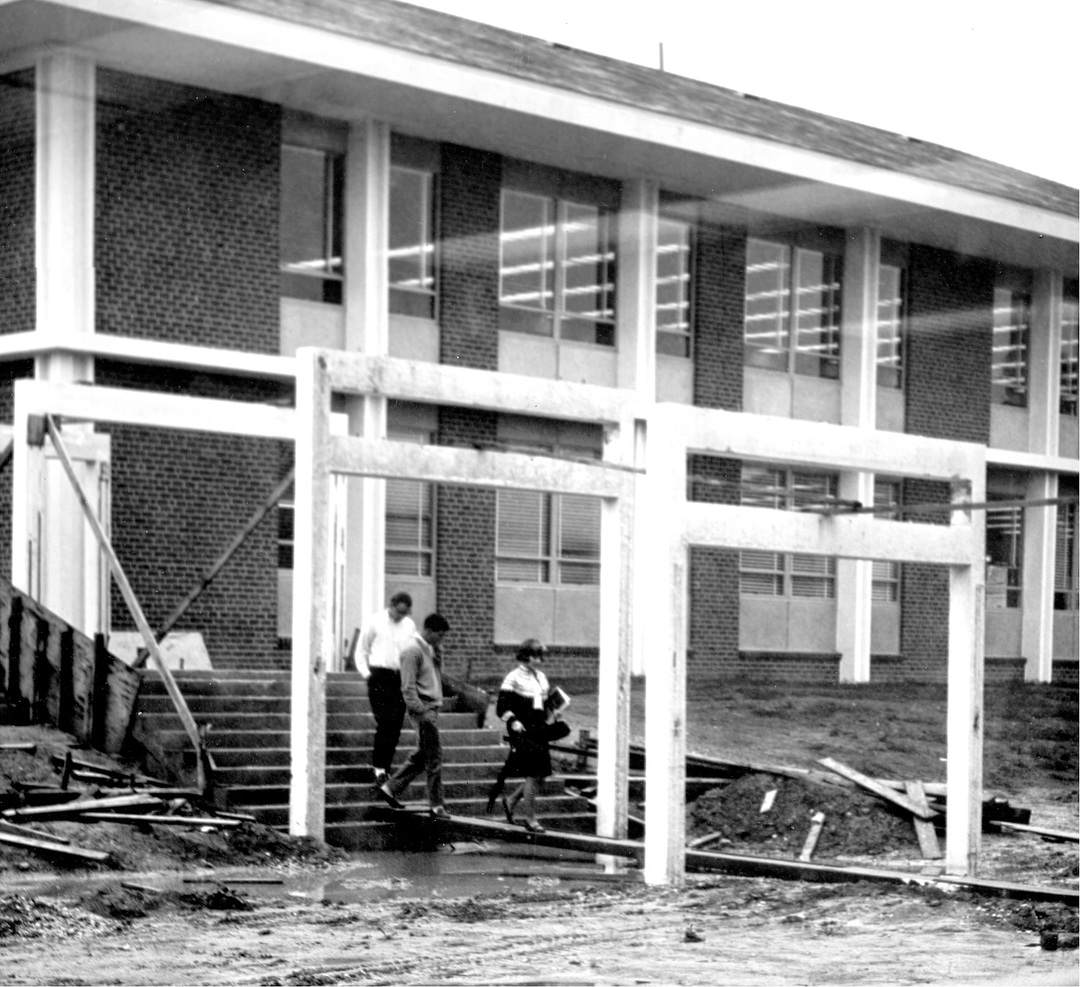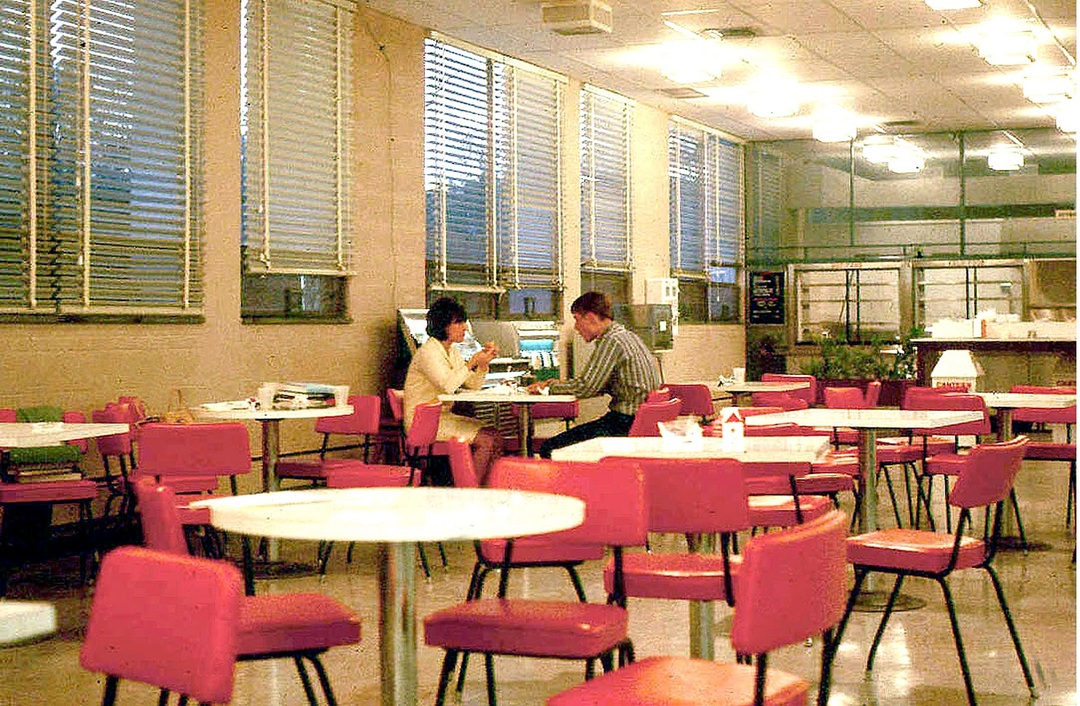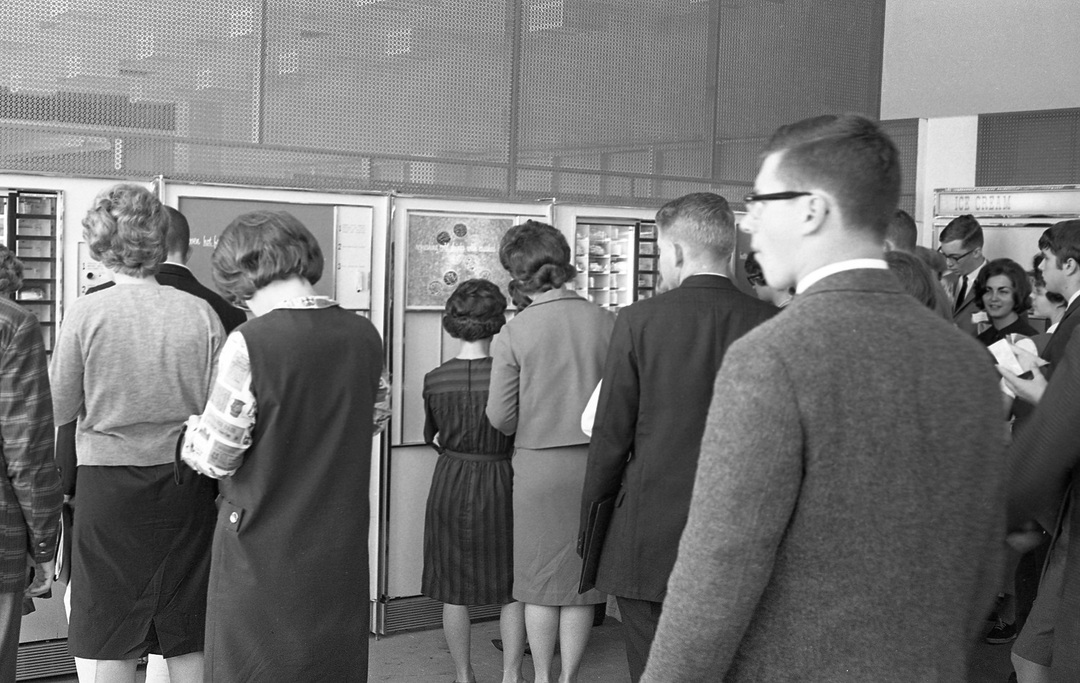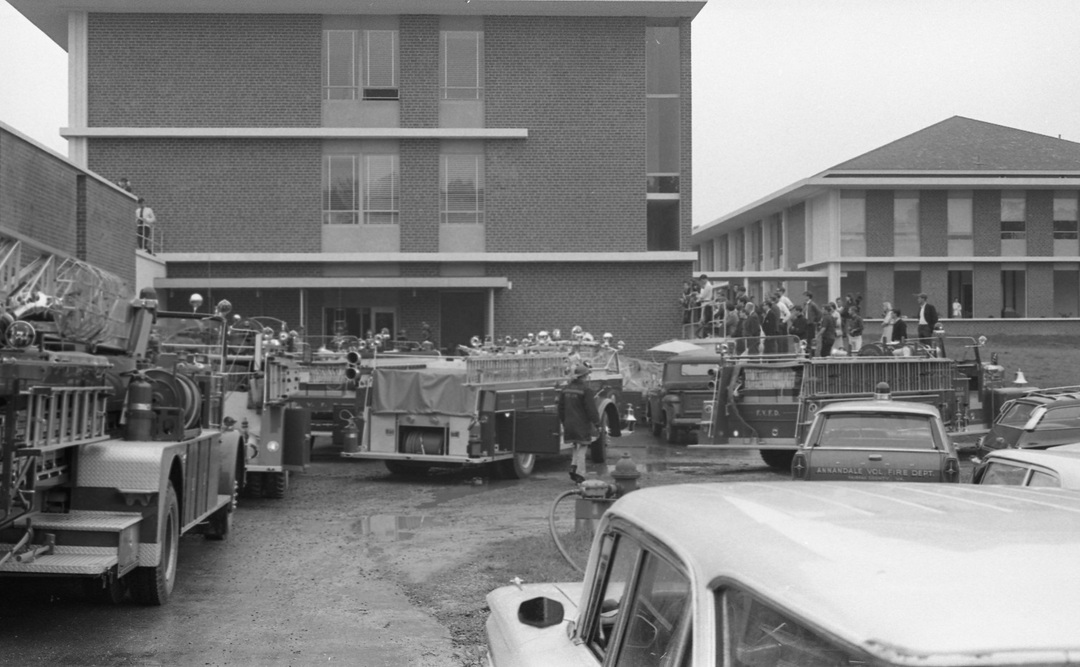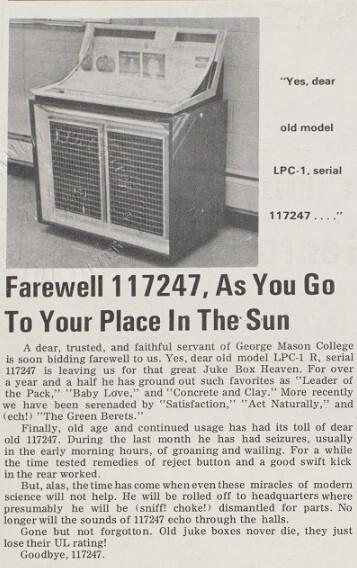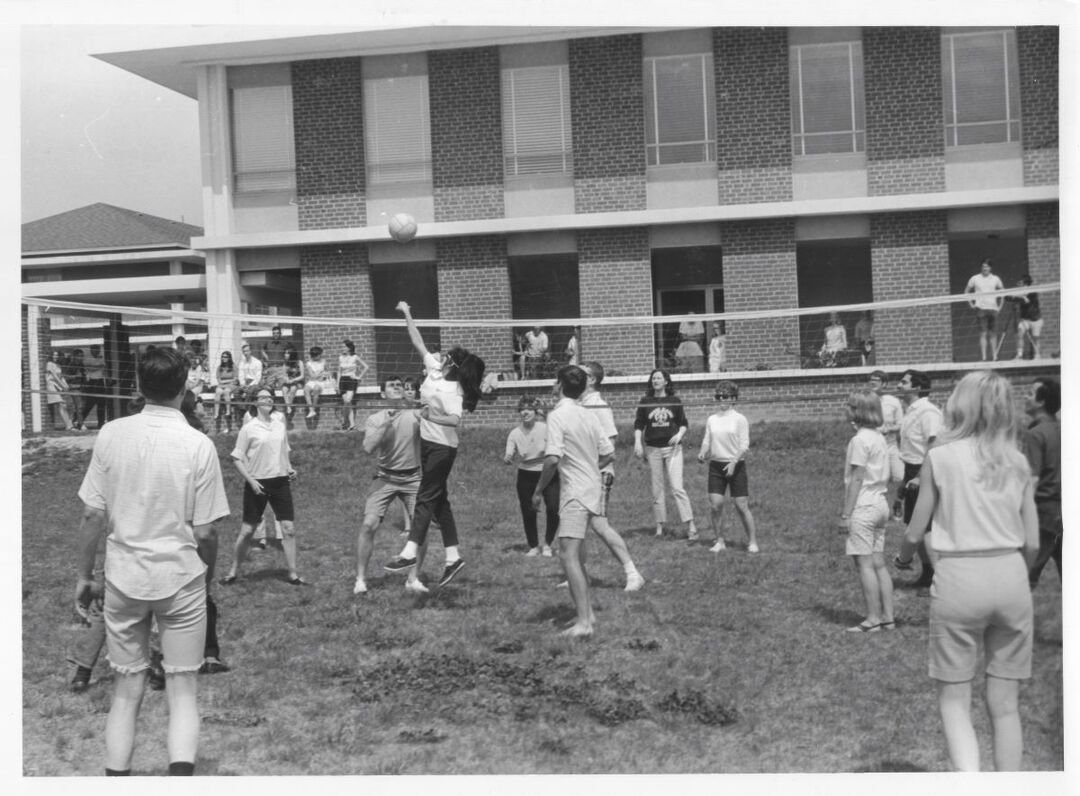The First Four Buildings at the Fairfax Campus
North, South, East and West Buildings
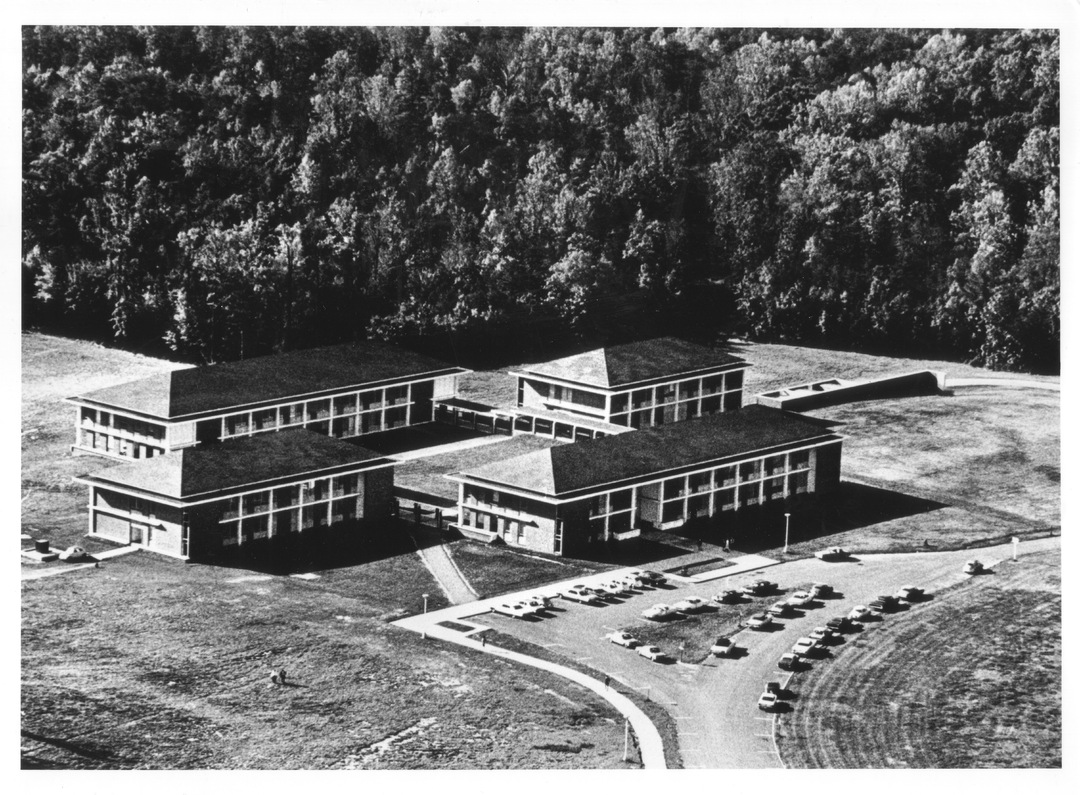
The Fairfax campus opened in September 1964 with only four buildings. From then until 1974, these original buildings were the center of Mason student life and the site of many notable events.
A groundbreaking ceremony for the new Fairfax campus was held on August 1, 1963. Students at Bailey’s Crossroads knew of the construction, but few were interested in following it. Student photographers Jim Wilson and Bill Flandermeyer visited the campus while it was under construction and took some of the earliest photographs of the Fairfax campus.
The campus at Fairfax officially opened on Monday, September 14, 1964, to 356 registered students. This number represented a 58% increase in the student population from the final school year at Bailey’s Crossroads. The original campus consisted of four buildings, named North, South, East and West, each for the direction it faced. Because the campus was initially small, students spent much of their campus life from 1964 to 1974 in these first four buildings. The then-state-of-the-art buildings were designed and built by local businesses Joseph Saunders & Associates of Alexandria and Eugene Simpson and brother, respectively.
On opening day, Mason’s new director, Robert Reid, boasted to the Fairfax Times that Mason was the first fully air-conditioned college in the Washington, D.C., area. Air conditioning was a welcome change for students and faculty who experienced the lack of climate control in the old school building at Bailey’s Crossroads. They were delighted with the spacious, top-of-line classrooms and laboratories. The air conditioning and brand-new facilities temporarily distracted them from realizing the campus lacked some essential amenities. During the first week, there was no faculty lounge or place for students to get food and beverages. Mason’s administration quickly set up vending machines in a study hall as a temporary solution.
The campus was formally dedicated on November 12, 1964. The ninety-minute dedication ceremony took place in front of the North Building. Nearly a thousand people attended, including prominent politicians, educators, members of the community and the local press.
Construction was still ongoing when the Fairfax campus opened. The sidewalks were incomplete, so planks were put down when it rained. The covered walkways between the buildings had yet to be constructed. Former students described the campus as “a sea of mud.” Even with the wooden planks, mud was difficult to avoid since students had to cross an unpaved path between the North and East Buildings to reach their gravel parking lot. Photographs from the 1965 to 1966 yearbook show that in addition to the completion of sidewalks and covered walkways, the roads around campus and parking spaces were paved, finally ending the mud problem.
South Building (Krug Hall)
By 1965, the students received a dining hall in the basement of the South Building. They named it the Ordinary, after the old English word for a pub. Chemical smells often drifted in from the biology and chemistry laboratories directly above. The Ordinary quickly became a popular hangout spot for students. Like their predecessors at the Bailey’s Crossroads campus, alumni from the Class of 1968 recalled playing competitive games of Hearts, Spades and Bridge. These card games were sometimes so intense that students nearly missed classes.
The Ordinary started serving fresh food in the fall of 1965. Articles in The Gunston Ledger frequently complained that the Ordinary was too crowded, so additional spaces for students to gather were added or improved in the East and West Buildings beginning in 1965. The Ordinary featured a jukebox. When the original jukebox died in April of 1966, a student penned an obituary for it in The Gunston Ledger commemorating its year and a half of service to students. The Gunston Ledger gleefully announced the purchase of a new jukebox for the Ordinary in October 1966. The Ordinary remained a gathering place for students until 1974 when the building that is now SUB I was completed.
Mason Day began in 1965 as a half-day of speeches and awards the day after UVA's Founder's Day celebration. During the 1968 to 1969 school year, Student Government Activities Chair, Mike Baker, transformed Mason Day into a multi-day spectacle of fun and entertainment. As part of Mason Day in 1969, for 3 days, 40 male students camped in tents behind the South Building. The event was labeled “Mason’s First Dormitories.” They ate their meals in the Ordinary, played sports on the lawn, roasted hot dogs, played music, watched movies and attended a presentation by local photographer Charles Baptie in the Lecture Hall, and staged a water balloon fight. Mason Tent City remained a tradition until 1977, when the university opened permanent dormitories.
North Building (Finley Building)
The North Building originally housed Mason’s administrative offices. An anonymous article in The Gunston Ledger, on November 16, 1967, decried that Mason was the only institution in Virginia without a flagpole. The writer implored students to find a way to raise $150 for a flagpole. The shaming worked, and a flagpole, which no longer stands, was installed in front of the North Building shortly after.
According to Broadside, beginning November 10, 1969, students stood in front of the flagpole in a memorial vigil of the lives lost in the Vietnam War. The previous month, the Vietnam War Moratorium Committee had presented Chancellor Lorin Thompson with a petition containing hundreds of signatures from students and faculty asking to be excused for one day of classes to participate in anti-war activities. Thompson rejected their petition. The vigils in front of the flagpole, visible from the administrative offices, were likely a response to his denial of their request.
The Vietnam War Moratorium Committee had officially scheduled to attend an off-campus event on November 14, 1969. So students were shocked when a group of protestors, in a spectacle Broadside called "Guerrilla Theatre", burned an American flag in the Ordinary. That same afternoon, Professor James Shea led students in burning draft cards in the Quadrangle. The Guerrilla Theatre incident divided the Vietnam War Moratorium Committee's student leaders, with Jim Corrigan speaking out against it and George Whelpley behind it. The Student Government was similarly divided, voting 6-3-3 to oppose disciplinary action against those responsible for the incidents. The Student Government supported Shea and asked the administration to retain him.
On the morning of May 6, 1970, Mason students asked Thompson to lower the flag in honor of students killed by the National Guard at Kent State University two days earlier. Thompson denied their request. A Kent State student spoke in the Quadrangle. Following the speech, a demonstration of fifty Mason students marched to the flagpole in an attempt to lower the flag by cutting the cord used to raise and lower it. Campus police confronted the demonstrating students. At noon, Thompson agreed to lower the flag to half-mast to accommodate the students and prevent any unrest.
East Building
The second floor of the East Building served as Mason's library until its free standing library was completed in late 1967. The entire East Building had originally been allotted for the library. However, the librarian generously gave two floors back to the college, which they used for classrooms and an additional lounge. In 1965, SAGE, a women’s organization on campus, hosted a fashion show in the East Building. On June 9, 1965, the first final day exercises were held in the East Building, and Mason’s class of 1965 received their diplomas. In 1968, the first class to graduate with Bachelor’s degrees from Mason put on their graduation robes in Eats before proceeding to the ceremony in the Lecture Hall.
West Building
The West Building became the center of attention at Mason on September 21, 1966. At 2:10 pm that day, a hot water pump motor in the boiler room burned out and caused an electrical fire. The building’s supervisor discovered it but found his telephone was out of order. He then drove to the Fairfax Fire Station to report to the fire alarm. Seven fire trucks from Fairfax, Vienna, and Annandale responded to the fire alarm. The fire marshal ordered everyone to evacuate the smoke-filled West Building upon arrival. Firefighters set up fans to blow the smoke out of the building. Once it cleared, they put out the fire with a regular fire extinguisher. No one was injured, but students and staff were inconvenienced because the fire knocked out all telephone service and many of the lights across campus. The food machines in the Ordinary also did not work. Classes were dismissed for the rest of the day.
Video
Audio
Images


